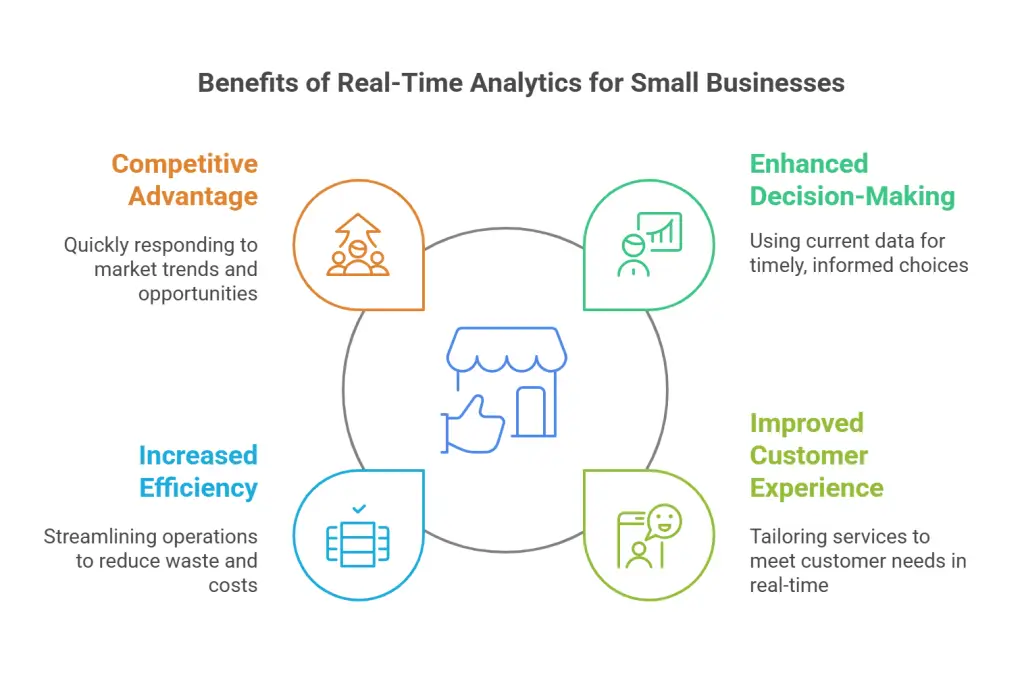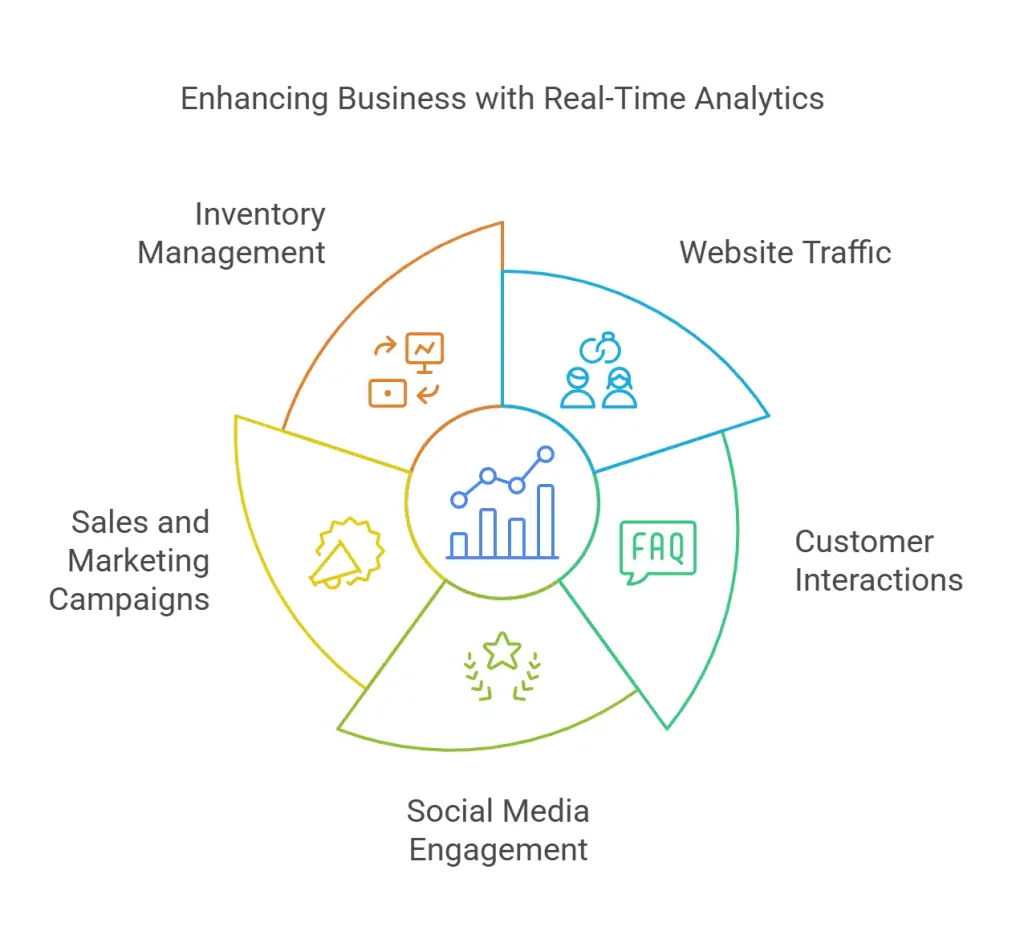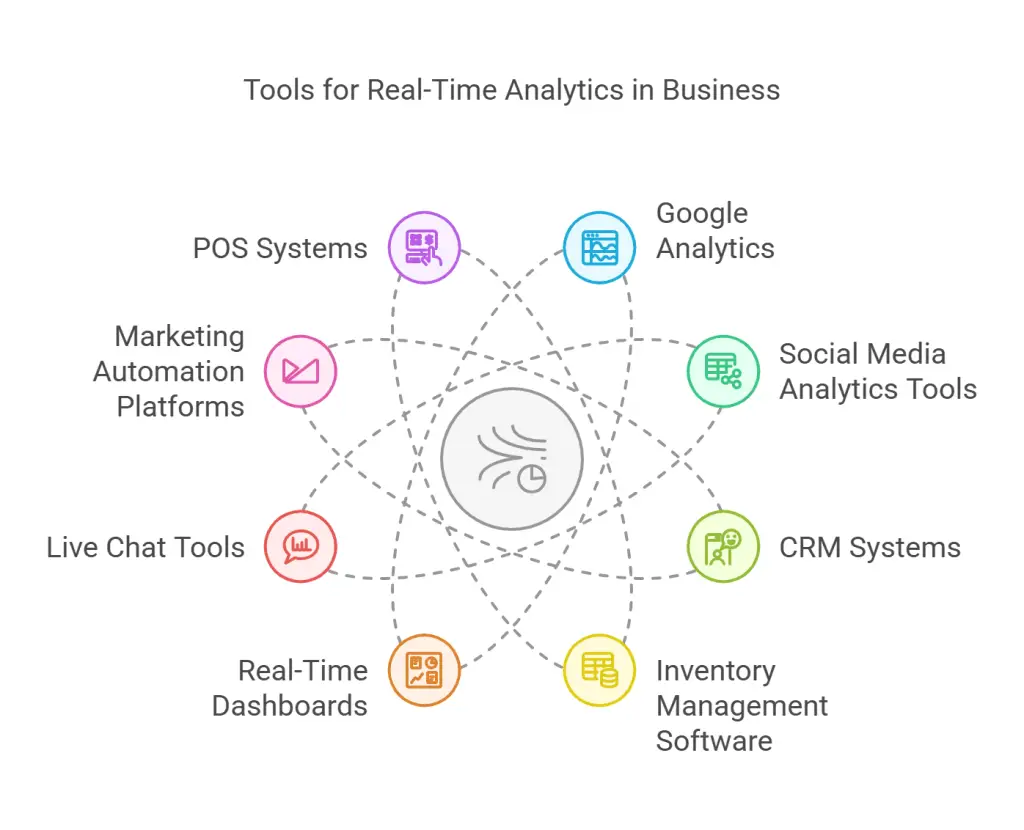Small businesses must make quick, data-driven decisions to stay competitive. Real-time analytics for small businesses is crucial for gaining immediate insights to guide those fast decisions. With real-time analytics, small businesses can monitor performance, identify trends, and adjust strategies swiftly.
Real-time analytics allows businesses to make immediate improvements in marketing, sales, and customer service. By analyzing data in real time, businesses can see what works and what doesn’t.
When implemented correctly, real-time analytics for small businesses can optimize operations and provide a significant competitive advantage.
What are Real-Time Analytics?
Real-time analytics for small businesses refers to the process of collecting, analyzing, and using data as soon as it becomes available. Unlike traditional analytics, which involves reviewing past data, real-time analytics allows businesses to make decisions based on the most current information. This immediacy is crucial in a business environment where trends and customer behaviors change quickly.
The role of real-time analytics for small businesses is to provide insights that improve operations, customer experiences, and profitability, enabling them to stay agile and responsive to opportunities and challenges.

Why Use Real-Time Analytics?
The benefits of using real-time analytics in your small business are vast and varied. Here are some of the most compelling reasons to integrate real-time analytics into your operations:
1. Enhanced Decision-Making
Real-time analytics enables small businesses to make decisions based on the most current data available. This immediacy ensures that decisions are made with the most relevant information, reducing the likelihood of errors and increasing the chances of success.
For example, a retail store owner could use real-time sales data to determine which products are selling well and adjust their inventory orders accordingly. Instead of waiting for a monthly report, they can act immediately to restock popular items, potentially increasing sales and customer satisfaction.
2. Improved Customer Experience
Understanding customer behavior as it happens allows businesses to provide a more personalized and responsive experience. Real-time analytics can reveal insights into customer preferences, purchasing patterns, and engagement levels, enabling businesses to tailor their offerings and interactions to meet individual needs.
Consider a small online business that monitors real-time data on website traffic. If they notice a spike in visitors to a particular product page, they could quickly offer a promotion or highlight related products to capitalize on that interest, enhancing the overall customer experience.
3. Increased Efficiency
Real-time analytics can streamline operations by identifying inefficiencies and areas for improvement. Whether it’s optimizing supply chain processes, reducing waste, or improving staff allocation, the ability to act on real-time data can lead to significant gains in efficiency.
For instance, a small restaurant could use real-time analytics to monitor inventory levels and adjust orders based on current sales trends, reducing food waste and saving money.
4. Competitive Advantage
In a competitive market, the ability to act quickly on new information can provide a significant edge. Real-time analytics allows small businesses to stay ahead of trends, respond to market changes, and outmaneuver competitors who may be slower to react.
A local boutique, for example, could use real-time social media analytics to identify a trending style and quickly promote related products, positioning themselves as a go-to destination for fashion-forward customers.

Where to Apply Real-Time Analytics in Your Business
Real-time analytics can be applied across various aspects of your business, offering valuable insights wherever data is generated. Here are some key areas where real-time analytics can make a significant impact:
1. Website Traffic
Monitoring website traffic in real time allows you to understand how visitors are interacting with your site. You can track which pages are most popular, how long visitors stay, and where they drop off. This information can be used to optimize your site layout, improve content, and increase conversions.
For example, if you notice that a significant number of visitors are abandoning their shopping carts, you could investigate potential issues such as confusing checkout processes or high shipping costs and address them immediately.
2. Customer Interactions
Real-time analytics can provide insights into customer interactions across various channels, including phone calls, emails, and live chats. By analyzing this data, you can identify common customer concerns, improve response times, and enhance overall service quality.
A small tech support company, for instance, could use real-time analytics to monitor call volumes and wait times, allowing them to adjust staffing levels dynamically to ensure customers receive prompt service.
3. Social Media Engagement
Social media platforms are a rich source of real-time data, offering insights into customer sentiments, engagement levels, and brand perception. By monitoring social media activity in real time, you can respond quickly to customer inquiries, address negative feedback, and capitalize on positive trends.
For example, a local bakery might notice an uptick in social media mentions after a new product launch. By engaging with customers and promoting the product further, they can build momentum and drive additional sales.
4. Sales and Marketing Campaigns
Real-time analytics can be invaluable in assessing the performance of sales and marketing campaigns as they unfold. By tracking metrics such as click-through rates, conversion rates, and sales figures in real time, you can make adjustments on the fly to improve outcomes.
A small e-commerce business could use real-time analytics to monitor the performance of a flash sale. If they see that sales are lower than expected, they might quickly adjust the pricing or extend the promotion to boost results.
5. Inventory Management
Keeping track of inventory levels in real time helps prevent stockouts and overstock situations. Real-time analytics can alert you to low inventory levels, allowing you to reorder stock before it runs out or reduce orders for slow-moving items.
For instance, a small electronics retailer could use real-time analytics to monitor inventory across multiple locations, ensuring that popular items are always available where they are most in demand.

When to Act on Real-Time Data
Real-time analytics provide valuable insights, but knowing when to act on that data is crucial for maximizing its impact. Here are some guidelines on when to take action based on real-time data:
1. Immediate Response to Customer Feedback
If real-time analytics reveal negative customer feedback or a spike in complaints, it’s essential to act quickly to address the issue. Whether it’s a product defect, a service failure, or a pricing concern, resolving the problem promptly can prevent further damage to your brand and customer relationships.
For example, if a small business owner notices a sudden increase in social media complaints about a recent product launch, they should investigate the issue immediately and communicate with customers to resolve it.
2. Capitalizing on Positive Trends
When real-time analytics highlight a positive trend, such as a surge in website traffic or an increase in social media engagement, it’s an opportunity to capitalize on the momentum. Acting quickly to promote popular products, engage with customers, or launch related campaigns can help sustain and amplify the trend.
A small fashion retailer, for instance, might notice a particular item trending on social media. By promoting the item further and offering a limited-time discount, they can boost sales and build on the excitement.
3. Adjusting Marketing Strategies
Real-time data can provide valuable insights into the effectiveness of your marketing strategies. If you notice that a particular campaign isn’t performing as expected, you can make real-time adjustments to improve its results.
For example, if a small business’s email marketing campaign is experiencing low open rates, they might experiment with different subject lines or send times to see if they can improve engagement.
4. Optimizing Operational Efficiency
Real-time analytics can help you identify inefficiencies in your operations and take immediate steps to address them. Whether it’s adjusting staff schedules, reallocating resources, or optimizing processes, acting on real-time data can lead to significant improvements in efficiency.
A small manufacturing business, for instance, could use real-time analytics to monitor production line performance. If they notice a bottleneck developing, they can adjust staffing or machinery to keep production running smoothly.
5. Preventing Potential Problems
Real-time analytics can also be used to identify potential problems before they escalate. By monitoring key metrics and setting up alerts, you can take proactive measures to prevent issues from impacting your business.
For example, a small logistics company might use real-time analytics to monitor delivery times. If they notice that deliveries are consistently delayed in a particular area, they can investigate the cause and take corrective action to avoid customer dissatisfaction.

Tools and Techniques for Implementing Real-Time Analytics
Implementing real-time analytics in your small business doesn’t have to be complicated or expensive. There are a variety of tools and techniques available that can help you collect, analyze, and act on real-time data effectively. Here are some recommendations:
1. Google Analytics
Google Analytics is a powerful tool that provides real-time insights into your website traffic and user behavior. With features like real-time reporting, you can monitor how visitors are interacting with your site at any given moment and make adjustments as needed.
For example, you can track how many visitors are on your site right now, which pages they’re viewing, and where they’re coming from. This information can help you optimize your site layout, content, and marketing efforts to improve user experience and increase conversions.
2. Social Media Analytics Tools
Platforms like Hootsuite, Buffer, and Sprout Social offer real-time analytics for social media, allowing you to monitor engagement, track mentions, and analyze the performance of your posts. These tools can help you stay on top of social media trends, respond to customer inquiries promptly, and optimize your social media strategy.
For instance, Hootsuite’s real-time monitoring feature lets you track mentions of your brand across multiple social networks, enabling you to engage with customers and address issues as they arise.
3. Customer Relationship Management (CRM) Systems
CRM systems like Salesforce, HubSpot, and Zoho CRM offer real-time analytics on customer interactions, sales performance, and marketing campaigns. These tools can help you gain insights into customer behavior, track sales pipelines, and measure the effectiveness of your marketing efforts.
With real-time data from a CRM system, you can monitor sales activity, identify opportunities for upselling or cross-selling, and ensure that your team is following up with leads in a timely manner.
4. Inventory Management Software
Tools like TradeGecko, Cin7, and Fishbowl offer real-time inventory management capabilities, allowing you to track stock levels, manage orders, and optimize your supply chain. These tools can help you prevent stockouts, reduce excess inventory, and improve order fulfillment processes.
For example, TradeGecko provides real-time inventory updates across multiple sales channels, ensuring that your inventory levels are accurate and that you can meet customer demand without overstocking.
5. Real-Time Dashboards
Real-time dashboards, such as those offered by Tableau, Power BI, and Google Data Studio, allow you to visualize and monitor key performance indicators (KPIs) in real time. These tools can help you track metrics like sales, customer satisfaction, and operational efficiency, making it easier to spot trends and make informed decisions.
With a real-time dashboard, you can customize your view to include the most important metrics for your business, ensuring that you always have the information you need at your fingertips.
6. Live Chat and Customer Support Tools
Live chat tools like Intercom, Zendesk, and Drift offer real-time analytics on customer interactions, enabling you to track response times, measure customer satisfaction, and optimize your support processes. These tools can help you provide faster, more effective customer service, leading to higher customer satisfaction and loyalty.
For instance, Zendesk’s real-time analytics feature lets you monitor customer support activity, track response times, and identify areas where your team can improve.
7. Marketing Automation Platforms
Marketing automation platforms like Mailchimp, Marketo, and ActiveCampaign offer real-time analytics on email campaigns, lead generation, and customer engagement. These tools can help you track the performance of your marketing efforts, segment your audience, and deliver personalized content based on real-time data.
For example, Mailchimp’s real-time analytics feature allows you to monitor the performance of your email campaigns as they unfold, helping you identify opportunities for improvement and make adjustments on the fly.
8. Point of Sale (POS) Systems
POS systems like Square, Shopify POS, and Lightspeed offer real-time analytics on sales transactions, inventory levels, and customer behavior. These tools can help you track sales performance, manage inventory, and optimize your in-store operations.
For instance, Square’s real-time analytics feature lets you monitor sales activity, track inventory levels, and analyze customer purchasing patterns, helping you make informed decisions about pricing, promotions, and inventory management.
9. Real-Time Alerting and Notification Tools
Real-time alerting tools like Slack, Zapier, and PagerDuty can help you stay on top of critical business events and respond quickly to emerging issues. These tools can be integrated with various systems to provide real-time notifications when specific conditions are met, such as a sudden drop in website traffic or a spike in customer complaints.
For example, Zapier can be used to set up real-time alerts that notify you when a new lead is captured on your website, enabling you to follow up promptly and increase your chances of converting the lead into a customer.
10. Data Integration and Automation Tools
Data integration tools like Zapier, Integromat, and MuleSoft can help you automate the flow of real-time data between different systems, ensuring that your analytics are always up to date. These tools can help you streamline your operations, reduce manual data entry, and ensure that your real-time analytics are accurate and actionable.
For instance, you could use Zapier to automatically update your CRM system with new customer data from your website, ensuring that your sales team always has the most current information when engaging with leads.

Conclusion
Real-time analytics offer small businesses the ability to make quick, informed decisions that can significantly impact their success. By understanding what real-time analytics are, why they’re essential, where they can be applied, when to act on the data they provide, and the tools and techniques available for implementation, small businesses can harness the power of real-time data to drive growth, improve efficiency, and stay competitive.
Incorporating real-time analytics into your business strategy doesn’t have to be overwhelming. Start by identifying the areas where real-time data can have the most significant impact, choose the right tools for your needs, and begin implementing real-time analytics in a way that aligns with your business goals.
With the right approach, real-time analytics can transform the way you operate, enabling you to make more informed decisions, respond quickly to changes, and seize opportunities as they arise. By staying ahead of the curve with real-time insights, your small business can thrive in today’s fast-paced, data-driven world.
Further reading
William & Mary Online. “Small Business Data Analytics: Everything You Need to Know.” Last accessed February 4, 2025. https://online.mason.wm.edu/blog/small-business-data-analytics-everything-you-need-to-know.
Geckoboard. “How to Set Up Real-Time Analytics for Your Business.” Last accessed February 4, 2025. https://www.geckoboard.com/blog/set-up-real-time-analytics-for-your-business/.
Putler. “Analytics for Small Business: How to Make Better Business Decisions.” Last accessed February 4, 2025. https://www.putler.com/analytics-for-small-business/.
CIOCoverage. “The Power of Real-Time Data Analytics for Small Business Growth.” Last accessed February 4, 2025. https://www.ciocoverage.com/the-power-of-real-time-data-analytics-for-small-business-growth/.
YouTube. “Real-Time Analytics for Small Businesses.” Last accessed February 4, 2025. https://www.youtube.com/watch?v=c3rwd1aURNI.
YouTube. “Using Real-Time Analytics to Drive Small Business Success.” Last accessed February 4, 2025. https://www.youtube.com/watch?v=Mp9pieFgYS4.
RedPanda. “The Benefits of Real-Time Analytics for Small Businesses.” Last accessed February 4, 2025. https://www.redpanda.com/blog/benefits-of-real-time-analytics.
Business.com. “Data Analysis for Small Business: Key Insights and Tools.” Last accessed February 4, 2025. https://www.business.com/articles/data-analysis-for-small-business/







